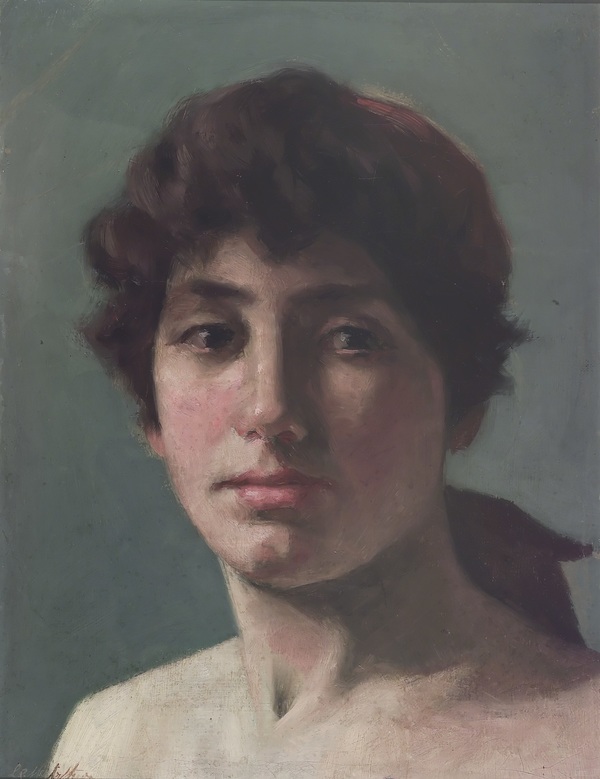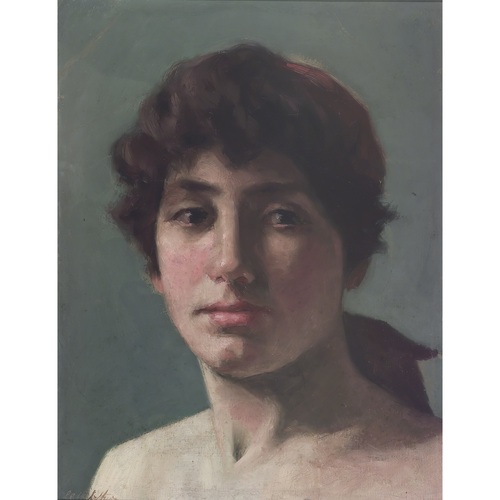
Source: Link
CASEY, LUCILLE C. (Kennedy; McArthur), artist and teacher; b. 1844 probably in Mississippi; m. first Evender C. Kennedy; m. secondly 1 July 1872 John Adolphus (Alexander) McArthur (MacArthur) in Montreal; no children were born of either marriage; d. 28 May 1902 on board the Lucania between England and Canada, and was buried in London, Ont.
Lucille C. Casey was the daughter of Colonel Casey, a Mississippi planter and member of the staff of Confederate general Robert E. Lee. She is said to have been related to Jefferson Davis, president of the Confederate states, and apparently was a member of one of the prominent Southern families living in Montreal after the American Civil War.
In 1872, after the death of her first husband, she married John Adolphus McArthur. Following his graduation in medicine from McGill College in 1879, she accompanied him to Clinton, Iowa, where he first practised. In 1884 the couple moved to Winnipeg; there he became a prominent physician and professor.
By the time she arrived in Winnipeg Lucille McArthur was a professional artist with good credentials: she had studied painting under William Raphael* in Montreal and china-painting at the studio of Edward Lycett in New York. In an evolving cultural community which lacked formal art institutions, she assumed a major role. She offered “superior instruction in all the higher branches of art” and a course in decoration. At the Agricultural and Industrial Exhibition of 1885 she contributed the largest group of works shown, ranging from copies and drawings from plaster casts to original subjects. That same year she also presented many pieces at the exhibition of the Historical and Scientific Society of Manitoba and was a member of the exhibition’s hanging committee. In 1886 McArthur and her husband helped to found the Winnipeg Art Society for the advancement of painting and drawing. The society held daily classes and sponsored occasional exhibitions of its members’ work. It was also instrumental in securing new quarters and an increased prize list for the fine arts at the agricultural exhibition.
It was McArthur’s ambition, however, to improve as an artist; her situation in life permitted her to obtain additional training and experience. In 1886, like an increasing number of aspiring artists in Canada, she sought tuition in Europe – an enterprising step for a woman of 42. For over two years she studied and visited galleries in Amsterdam, Munich, Rome, and Paris. In 1888 she attained a major goal: the acceptance of two paintings by the Paris Salon.
On her return to Winnipeg, McArthur held a weeklong exhibition of more than 100 original paintings, including landscape, still life, genre, and nude subjects, in a building downtown. It was Winnipeg’s first extensive solo show. The pictures that had hung in the Paris Salon attracted particular interest; another novelty was the nude section, in a curtained area. Despite a small admittance fee, attendance in the first three days exceeded 500 persons.
Following the exhibition McArthur returned to her former routine. Artistic life in Winnipeg was very limited, however, particularly when contrasted with that of Europe. Since the local agricultural exhibition had lapsed, she showed at the Minnesota State Fair in 1889. She spent the summer of 1890 in Montreal, but in 1891 she resumed her travels abroad, visiting England, the Continent, North Africa, and the Middle East. From that year onwards, she seldom returned to Winnipeg. Her husband continued his medical career there, occasionally joining her for a few months’ vacation in Europe. Meanwhile, she gained new recognition in Canada; her painting The gateway was among the select group chosen from exhibitions of the Royal Canadian Academy of Arts in Toronto and Montreal to hang at the Columbian exposition in Chicago in 1893.
Lucille McArthur’s work is difficult to evaluate, since few examples are known to exist, but The boy with a red cap shows her to be an able artist in the academic tradition, a judgement confirmed by her inclusion in the Paris Salon and the Chicago world’s fair. In Winnipeg, despite her long absences, she was a pioneer who passed on skills and concepts not otherwise available. She also demonstrated that European training was available for western Canadian women, but that it was not easy to adapt it to local conditions. Her life illustrates the potentialities and frustrations of an early art career in Manitoba.
[Two of Lucille McArthur’s paintings are in the collections of the Winnipeg Art Gallery. The location of others, known to be in private hands some years ago, cannot now be traced. v.g.b.]
ANQ-M, CE1-63, 1er juill. 1872. Daily Manitoban (Winnipeg), 30 Sept. 1885. London Advertiser, 12 July 1872. Manitoba Sun (Winnipeg), 10 May 1886, 2 Oct. 1888. Morning Telegram (Winnipeg), 7 June 1902. Strathroy Age (Strathroy, Ont.), 5 June 1902. Winnipeg Free Press, 1 Jan., 1, 20, 22 Oct. 1885; 11 March, 28 June, 11 Aug. 1886; 17 Sept., 3, 4 Oct. 1888; 7 Sept. 1889; 3 Nov. 1890; 21 April 1891; 10 Feb., 5 Nov. 1892; 27 Aug. 1934. Winnipeg Tribune, 22 April 1891; 15 Feb., 5 Nov. 1892; 15 April 1893. Virginia Berry, Vistas of promise, Manitoba, 1874–1919: November 1st, 1987–January 17th, 1988 (Winnipeg, 1987). W. E. Dodd, Jefferson Davis (New York, 1966). Manitoba, pictorial and biographical (2v., Winnipeg, 1913).
Cite This Article
Virginia G. Berry, “CASEY, LUCILLE C. (Kennedy; McArthur),” in Dictionary of Canadian Biography, vol. 13, University of Toronto/Université Laval, 2003–, accessed December 26, 2025, https://www.biographi.ca/en/bio/casey_lucille_c_13E.html.
The citation above shows the format for footnotes and endnotes according to the Chicago manual of style (16th edition). Information to be used in other citation formats:
| Permalink: | https://www.biographi.ca/en/bio/casey_lucille_c_13E.html |
| Author of Article: | Virginia G. Berry |
| Title of Article: | CASEY, LUCILLE C. (Kennedy; McArthur) |
| Publication Name: | Dictionary of Canadian Biography, vol. 13 |
| Publisher: | University of Toronto/Université Laval |
| Year of publication: | 1994 |
| Year of revision: | 1994 |
| Access Date: | December 26, 2025 |



